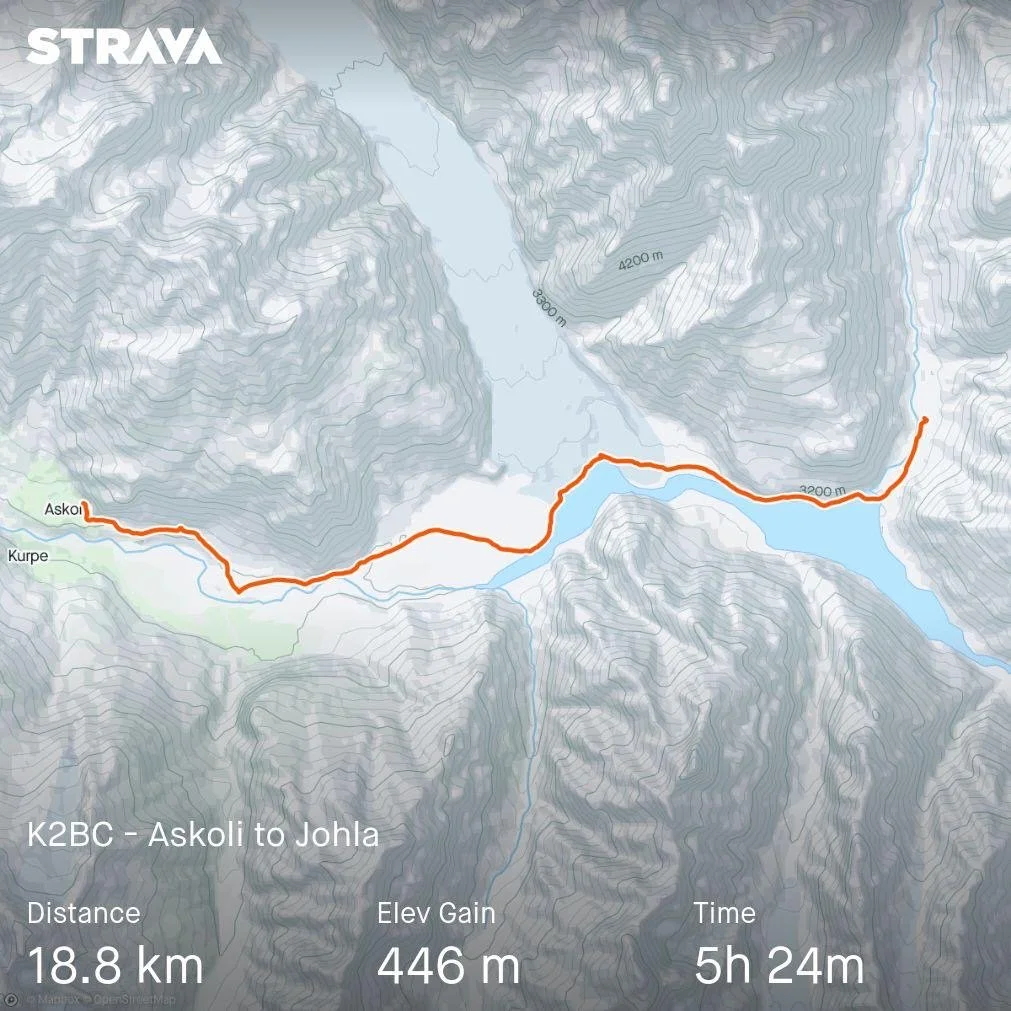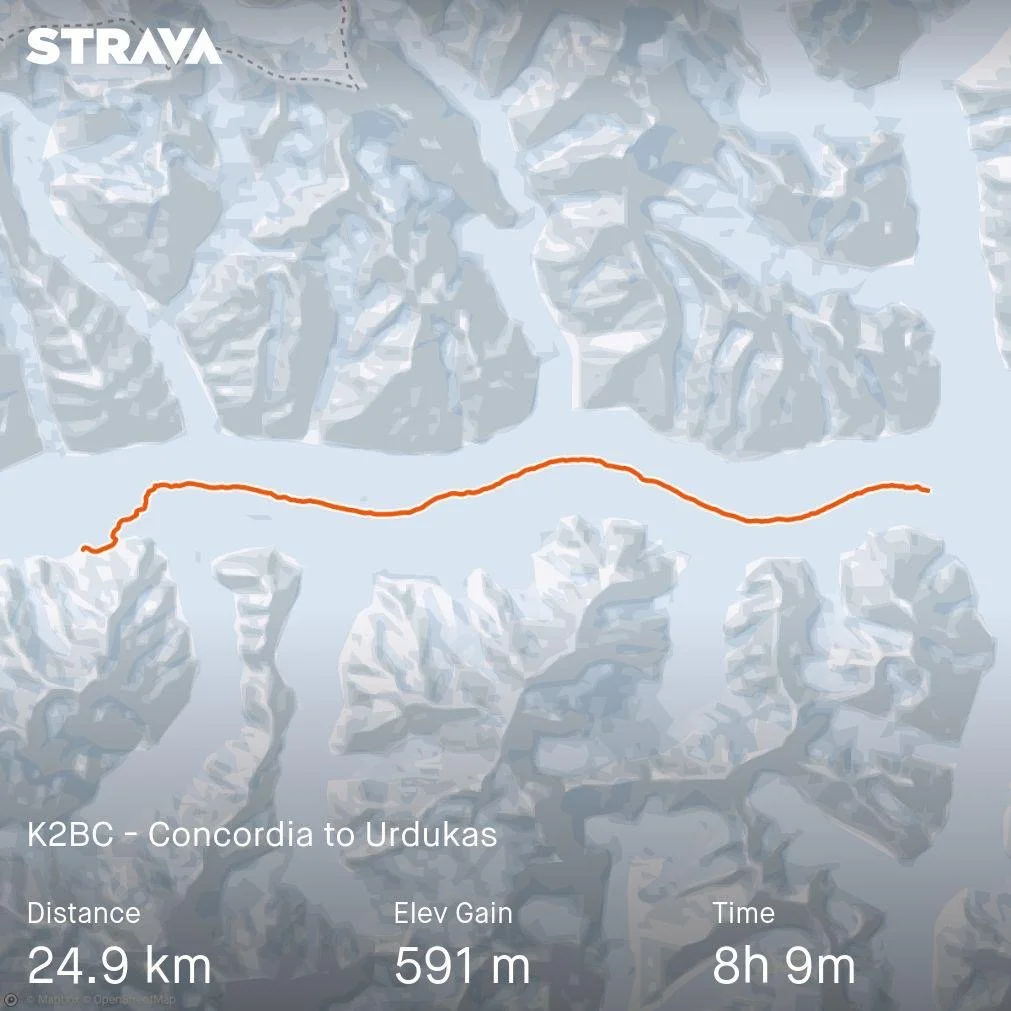K2 Base Camp Trek - July 2024
Pakistan is a country I always thought I would visit for work, so it felt strange to be sitting on a flight to Islamabad, trying to enter the mindset that this was a holiday instead. The visa process had been reasonably simple, albeit slow due to the early 2024 elections. We needed a specific trekking visa since the region we were heading to, in the north, is part of Kashmir—a disputed territory bordering Afghanistan, China, and India.
I’ve been told many times that for a Muslim, when given the opportunity to travel to Mecca for Hajj, one must take it. During this journey, it was suggested that I might have a similar attitude toward trekking experiences. Admittedly, a couple of months before my wedding wasn't the ideal timing, but when my good friend Dom asked if I wanted to tackle K2 Base Camp, I knew I needed to be on that plane. These journeys have become spiritual for me, immersing myself in nature with a single daily goal—to reach the next camp. They challenge you physically and mentally, pushing you to your limits while allowing you to escape the stresses of modern life and focus on achieving your goal (and, in this trek, survival!).
Islamabad - Skardu - Askole
The first challenge was reaching the trek's starting point—an incredibly remote area of the world. After a couple of days of enjoying great food in Islamabad, we flew with the rest of the team to Skardu, in Gilgit-Baltistan. Upon arrival, we learned that another team member, Klaus, had driven from Italy as part of a longer journey, and planned to attempt summiting Pastore Peak after reaching K2 Base Camp. Suddenly, I felt shy about mentioning my previous experiences, which paled in comparison!
The next day, we had an early start, piling into Land Cruisers to make the drive to Askole along some of the most terrifying roads I’ve seen. Huge drops, rocky roads, and bouncing wooden suspension bridges greeted us. I was thankful that our driver appeared to be an unearthed World Rally Championship gem, navigating every danger with ease. The final challenge of the drive was passing a section of the road washed away by a landslide a couple of days prior. We had to jump out of the cars and literally jump across the now fast-flowing waterfall that had replaced the road. It was a hell of an intro to what we should have expected over the next couple of weeks.
It was immediately clear that we had a great team for this experience. We had representation from across the globe—UK, Germany, Italy, USA, South Korea, Canada, Australia, and Russia—with a mix of ages and genders. The global idealist in me felt proud to be part of this group, confident that we would support each other in achieving our goal. Of course, we also had our team of Pakistani guides and porters, without whom it would not be possible to reach K2 Base Camp.
Askole - Paiju
The first couple of days of trekking were in tough hiking conditions. There wasn’t a cloud in the sky, and the trail offered zero shade, leaving us completely exposed to the beating sun. Both days involved long hikes of around 20 km each. At the end of the first day in Johla, I suffered a combination of minor heat stroke and food/water poisoning, spending most of the night either hallucinating or stumbling to the toilet block (thankfully, there was one at this camp). I recall trying to take some photos of the Milky Way above Bakhordas mountain, feeling completely out of it, and using most of my effort just to stand still rather than focus on the camera settings!
This led to an incredibly difficult second day, trekking again in the blazing heat with zero energy, having not slept or been able to eat anything. Even drinking water was a challenge, as it would inevitably come straight back up. Saad, the third Brit in our contingent, was also struggling with similar issues, so my only goal that day was to keep his umbrella in sight and try to keep pace with the group. Thankfully, our guides, Ahmed and Hussain, helped me get through the challenge, patiently waiting every time my body forced me to stop.
Arriving in Paiju was a glorious moment, especially knowing we would rest there the following day to recuperate after a brutal introduction to the Karakoram mountains. I was able to recover, start eating again, and, most importantly, catch up on sleep.
Paiju - Urdukas
Feeling refreshed from our day of rest, we set out from Paiju towards the Baltoro glacier, which would be our home for the next week. It was raining lightly, a relief after the intense sun of previous days. It felt great to tackle the hike at full strength and enter this huge glacier. However, after lunch, the rain intensified, and our path along the mountainside between Liligo and Khoburtse was blocked by a mud/rockslide, forcing us onto the glacier. We followed footsteps from a porter who had come the opposite direction, but they seemed to vanish, leaving us lost on the unstable glacier. I remember looking at Klaus, who is a mountain guide himself, and seeing fear in his eyes as he scanned the area for a route back to the path. I don’t know if I’ve dramatised the moment in my mind, but looking back, it felt like things could have gone south quickly. I’m very thankful that Ahmed managed to find a route back to safety.
Once in Khoburtse, our camp was set up, and we enjoyed a pleasant evening, drying out. The next day was relatively easy, with decent cloud cover and a shorter trek, crossing a couple of ‘side’ glaciers to reach Urdukas. The only incident was being barrelled into by a mule, sending me flying into Craig, an American from Colorado, and we both tumbled onto the rocks. Fortunately, he didn’t suffer any injuries, and the only harm was to my ego, so we laughed it off! This was our last night beside the Baltoro glacier before making the charge down the centre of it to Concordia.
Urdukas - Concordia
Entering back onto the Baltoro glacier from Urdukas, we made our way towards Goro II, where we would camp directly on the glacier. The glacial hiking here was less undulating but much more slippery. The rocky surface was like fine pebbly sand, punishing us whenever we looked anywhere other than our feet. My favourite moment that day was when Nauman, the Canadian in the group, arrived at the lunch spot and declared, “There’s a lot of ice!” While objectively a funny thing to hear on a glacier, it summed up the day well. We had been hiking on the glacier before, but this was the day we really felt it.
Watching the sunset together at Goro II was special, as it always is when you see the last light hit a mountain peak. We had a spectacular view of Masherbrum (K1) from the campsite, and I recall feeling very content. We had expected to receive phone signals for the first time during the trek, and while I wanted a couple of bars of 4G to speak to Elisabetta (and check the Euro 2024 results), I was happy to continue living off the grid for another day, enjoying moments like this. Will, the other American in the group, had brought a Garmin Reach and kindly messaged our loved ones daily with updates, giving us peace of mind.
Sleeping in a tent on the glacier was a cool experience, albeit uncomfortable. It’s hardly the flattest of surfaces, full of rocks and stones, and pretty cold too! At Goro II, we ended up having the ‘British Quarter,’ with Saad’s tent next to ours. Despite the discomfort, I slept well, no doubt helped by being utterly exhausted from the day’s exertion.
We expected the path from Goro II to Concordia to be relatively easy compared to what we had already faced, but it was a long day. The glacier hiking here takes its toll on you mentally. As I mentioned before, if you lose concentration for even a moment, you slip on the ice and have to save yourself from falling. It was a relatively straight route towards Concordia, with Gasherbrum IV growing larger in front of us. There was a sense of anticipation, as K2 is not visible until you reach the camp. The day was full of clouds, and we were concerned we wouldn’t see K2, but fortunately, the clouds cleared shortly after we arrived, revealing the second-largest and one of the most dangerous mountains in the world.
That evening, I ate dinner quickly (it was always served at sunset) and rushed out to watch the sunset alone. Inspired by K2’s isolation among all these giants, I wanted a moment of solitude and reflection. Sitting there, watching the last light of the day hit the surrounding peaks one by one, was incredible. First, the 6,000-metre peaks, then the 7,000s, and finally, the 8,611-metre beast. It was wrapped in a blanket of cloud, swirling around its peak—a tranquil moment from a distance but savage conditions upon it. I stayed until twilight before finally retreating to warm up.
Concordia - Broad Peak & K2 Base Camp - Concordia
As a group, we decided to head straight to K2 Base Camp, skipping a night at Broad Peak Base Camp. This meant a long day trekking to BPBC, then K2BC, and back to BPBC, but the conditions were decent enough to justify the decision.
We made our way down (or up, I guess) the glacial corridor towards K2, marvelling at its magnificence before stopping for lunch at BPBC. After lunch, we continued to K2BC, achieving our goal of reaching the camp where real mountaineers were planning their incredible expeditions up the mountain. We didn’t see Nims who was apparently there, but there was an Italian expedition camp (CAI), giving us hope for a proper coffee—alas, they weren’t in the mood for visitors, and this hope was dashed.
In general, I found K2BC to have a bit of an odd atmosphere. The conditions hadn’t been great, and there was a lot of anguish and worry that the planned expeditions wouldn’t be successful. It was a cold, harsh place at over 5,000m altitude, affecting everyone it seems, even the mountaineers!
After some photos with the sign and a cup of tea, we returned to BPBC to spend the night in the most uncomfortable place I’ve ever slept. My body was contorted between large rocks, doing nothing to relieve a back pain that had crept in days prior. Fortunately, the next day was a short hike back to Concordia, where we could nap and recover before gathering for a final night of K2 viewing. That morning, we bid farewell to Klaus as he left to attempt summiting Pastore Peak.
We had a big decision to make that evening in Concordia: whether to return the way we came or go over the Gondogoro Pass to Hushe. Given the poor conditions and a few hairy moments on the trek, we decided as a group that our primary goal was to return safely to our families. While this was a difficult decision (not least because it meant a longer route), it was the right one. This is not an area to take risks; the consequences of wrong decisions are severe.
Concordia - Askole
We took three days to return from Concordia to Askole, covering 80 km. Fuelled by a hunger to return to civilisation and comfort, we made good pace on the return, aided by the increasing oxygen levels.
Descending a mountain or trek the way you came up is a strange experience, like reliving a highlights package of your journey. We witnessed some changes in the scenery, such as the Trango Towers fully revealed after being shrouded in cloud, and new angles of Masherbrum.
Stepping off the Baltoro glacier on the way to Paiju was amazing. While stepping onto it on the third day of trekking was incredible, getting off felt even better. This absolute monster saps your energy and spirit, requiring 100% concentration and punishing any misstep. Walking on a sandy path felt like "traveling on the airport travelator," as Dom elegantly put it. On the final day, we upped the pace, traversing 35 km from Paiju to Askole. I will admit that I was partly motivated by a desire to watch the Euro 2024 final that evening between England and Spain, but alas, there was no TV, radio, or strong internet signal. England lost anyway, so perhaps it was for the best.
Finishing a trek is always emotional, as endorphins and a deep sense of achievement wash over you. This was made even more so when we heard Klaus had completed his challenge of summiting Pastore Peak and was to join us later that evening in Askole. It's his story to tell, so I won't recount it here, but it was emotional to see him after a few days and to feel the connection with the group, reunited at the last moment and having achieved our goal. Almost everyone suffered illness or difficulties at some point, and I know I wouldn’t have made it through the first few days without their support. Whether it was chatting about country life in Australia with Karen, joking about German habits with Sabine, learning about Korean & Chinese (and Gen Z) culture with Will & Sam, smoking high-altitude cigarettes with Dasha, dreaming of homemade Italian food with Klaus, quizzing Craig on Silicon Valley, taking part in Nauman’s selfies, generally just being British with Saad, or enjoying time with one of my closest friends—this group was special. It was an absolute honour and privilege to experience this trek with them.
That being said, I’ve been asked a couple of times since returning if I would do this trek again. The answer is absolutely no! 😂

















































































